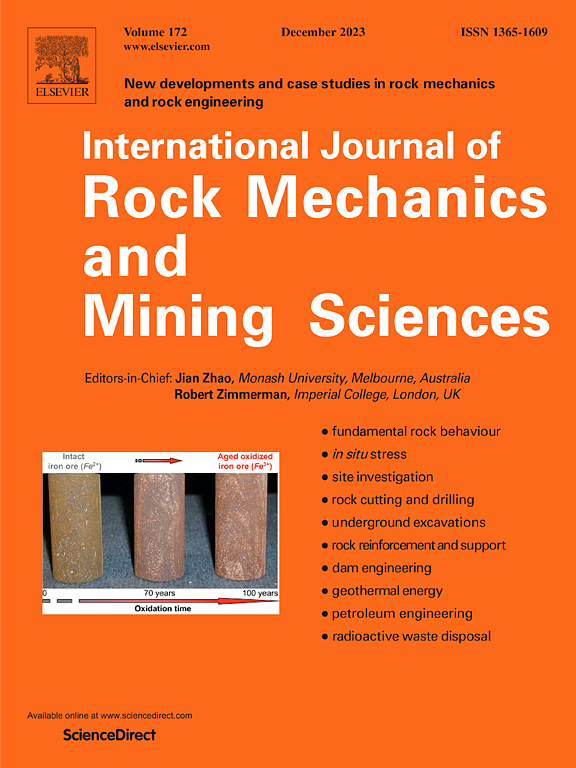Experimental and numerical characterization of hydro-mechanical properties of rock fractures: The effect of the sample size on roughness and hydraulic aperture
IF 7
1区 工程技术
Q1 ENGINEERING, GEOLOGICAL
International Journal of Rock Mechanics and Mining Sciences
Pub Date : 2025-02-01
DOI:10.1016/j.ijrmms.2024.106009
引用次数: 0
Abstract
This paper investigated fluid flow in low-stress conditions through rock fractures in Kuru granite measuring 25 cm × 25 cm. Physical aperture and roughness were measured using high-precision photogrammetry. Anisotropy in roughness was observed in two perpendicular directions. Physical aperture under normal stresses was measured, and fracture closure was compared with linear variable displacement transducer (LVDT) measurements, showing good agreement. Hydromechanical tests exhibited nonlinear behavior between fluid pressure gradient and flow rate, following the Forchheimer equation. Applying normal stress resulted in decreased hydraulic aperture and increased nonlinearity of fluid flow. Experimental hydromechanical tests also revealed anisotropy in perpendicular directions, aligning with fracture roughness measurements. Photogrammetric models, aided COMSOL simulations, closely matched the experimental results. Increased stress induced channeled flow and greater tortuosity. Validation of the numerical model allowed simulations on larger fractures. A 2 m × 1 m granite fracture studied scale effects, with the rough surface duplicated and shifted by 350 μm to align with initial aperture measurements of 25 cm × 25 cm samples. Fluid flow simulations assessed subsample sizes (5 cm–100 cm), showing size-dependent variations in roughness, hydraulic aperture, and non-Darcy coefficient, stabilizing beyond 30 cm. This underscores sample size's role in parameter stabilization beyond a 30 cm scale.
岩石裂隙水力学特性的实验与数值表征:试样尺寸对粗糙度和水力孔径的影响
本文研究了库鲁花岗岩25 cm × 25 cm岩石裂缝在低应力条件下的流体流动。采用高精度摄影测量法测量物理孔径和粗糙度。在两个垂直方向上观察到粗糙度的各向异性。测量了正常应力下的物理孔径,并将裂缝闭合度与线性变量位移传感器(LVDT)测量结果进行了比较,结果吻合良好。流体力学试验表明,流体压力梯度与流量之间存在非线性关系,符合Forchheimer方程。施加法向应力导致液压孔径减小,流体流动非线性增大。实验流体力学测试也显示了垂直方向上的各向异性,与裂缝粗糙度测量结果一致。借助COMSOL模拟的摄影测量模型与实验结果非常吻合。增加的应力引起的通道流动和更大的弯曲。数值模型的验证允许在更大的裂缝上进行模拟。研究了2 m × 1 m花岗岩裂缝的尺度效应,将粗糙表面复制并移动350 μm,以与25 cm × 25 cm样品的初始孔径测量结果一致。流体流动模拟评估了子样本尺寸(5 cm - 100 cm),显示了粗糙度、水力孔径和非达西系数的尺寸相关变化,稳定在30 cm以上。这强调了样本大小在超过30厘米尺度的参数稳定中的作用。
本文章由计算机程序翻译,如有差异,请以英文原文为准。
求助全文
约1分钟内获得全文
求助全文
来源期刊
CiteScore
14.00
自引率
5.60%
发文量
196
审稿时长
18 weeks
期刊介绍:
The International Journal of Rock Mechanics and Mining Sciences focuses on original research, new developments, site measurements, and case studies within the fields of rock mechanics and rock engineering. Serving as an international platform, it showcases high-quality papers addressing rock mechanics and the application of its principles and techniques in mining and civil engineering projects situated on or within rock masses. These projects encompass a wide range, including slopes, open-pit mines, quarries, shafts, tunnels, caverns, underground mines, metro systems, dams, hydro-electric stations, geothermal energy, petroleum engineering, and radioactive waste disposal. The journal welcomes submissions on various topics, with particular interest in theoretical advancements, analytical and numerical methods, rock testing, site investigation, and case studies.

 求助内容:
求助内容: 应助结果提醒方式:
应助结果提醒方式:


